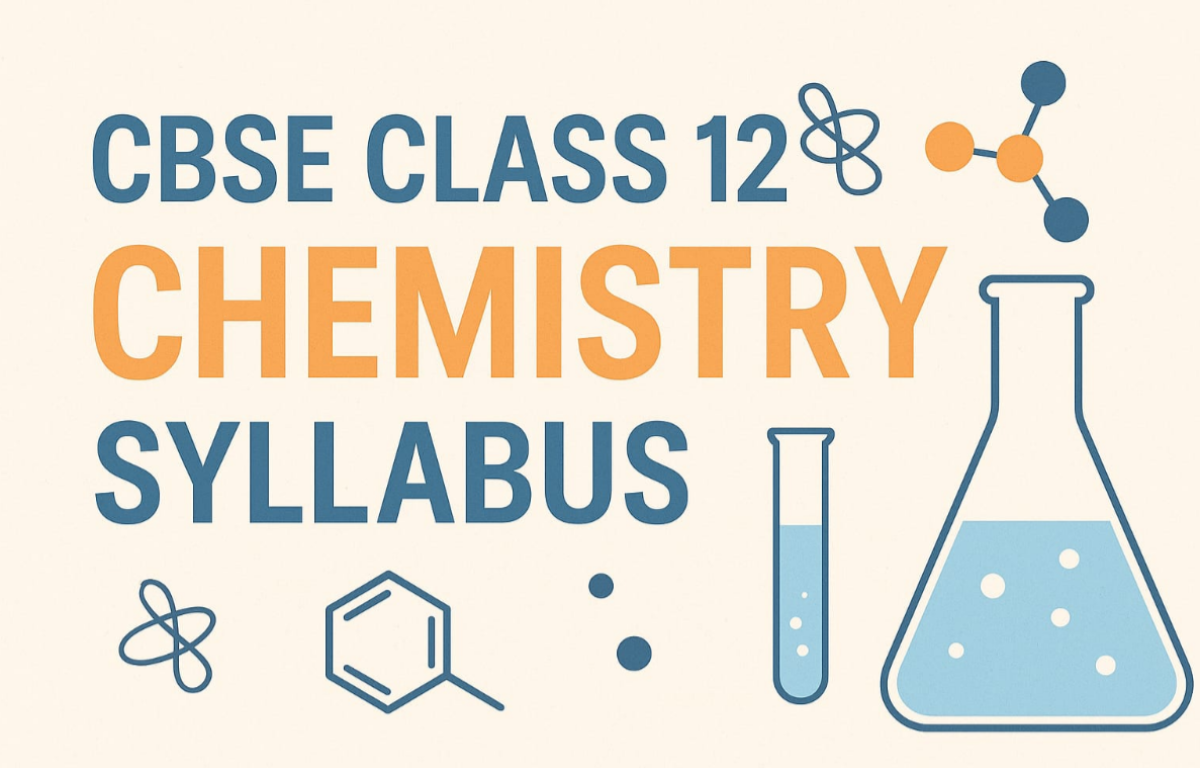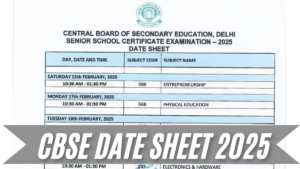CBSE Class 12 Chemistry Syllabus 2025-26: All the science stream students with Chemistry as one of their major subjects must have started their preparation for the final board exams. And to start the preparation, students need to firstly go through the CBSE Class 12 Chemistry Syllabus carefully to score well in the exams. Students can now check and download their newly updated syllabus for the academic year 2025-26 by simply visiting the official website of the Central Board of Secondary Education, i.e., www.cbseadamic.nic.in.
They can also check the detailed unit-wise breakdown of Physical, Organic, and Inorganic Chemistry syllabus in the article below. Along with the syllabus, students are advised to also check important topics, exam pattern, marking scheme, and the most important CBSE Class 12th Chemistry Sample Papers with solutions to practice more effectively. The class 12 Chemistry syllabus not only includes the theory part but also covers practical experiments to enhance problem-solving and application-based learning.
CBSE Class 12 Chemistry Syllabus 2025-26
The CBSE has formally released the Class 12 Chemistry curriculum for the 2025–2026 academic year. It provides students with a thorough understanding of the subject by covering ten in-depth units. The test consists of two sections: 30 marks for practical work and the rest 70 marks are for the theory exam. Students can better plan their preparation and know exactly what to study thanks to this well-organized syllabus. They can lessen exam anxiety, manage their time effectively, and concentrate on the key subjects by following it step-by-step. Students who prepare according to the syllabus not only develop solid concepts but also perform better, increasing their confidence and readiness to achieve high scores on their board exams.
CBSE Class 12th Chemistry Unit Wise Syllabus 2026
As per the newly updated CBSE Class 12th curriculum, the chemistry syllabus is divided into 9 different divided, which are further divided into Physical, Organic, and Inorganic Chemistry. Students can check the detailed unit-wise CBSE Class 12th Chemistry Syllabus in the table shared below.
| CBSE Class 12th Chemistry Unit-Wise Syllabus 2025-26 | ||
| Unit | Name of the Unit | Marks |
| Unit 1 | Some Basic Concepts of Chemistry | 07 |
| Unit 2 | Structure of an Atom | 09 |
| Unit 3 | Classification of Elements and Periodicity in Properties | 06 |
| Unit 4 | Chemical Bonding and Molecular Structure | 07 |
| Unit 5 | Chemical Thermodynamics | 09 |
| Unit 6 | Equilibrium | 07 |
| Unit 7 | Redox Reactions | 04 |
| Unit 8 | Organic Chemistry: Some Basic Principles and Techniques | 11 |
| Unit 9 | Hydrocarbons | 10 |
| Total | 70 Marks | |
CBSE Class 12 Chemistry Syllabus 2025-26 [Detailed]
To help students prepare for their exams, the CBSE Class 12 Chemistry Syllabus 2025–2026 has been provided here in a comprehensive, chapter-by-chapter or unit-by-unit format. This revised syllabus serves as the ideal road map, assisting students in determining which subjects are more crucial and demand more attention in order to achieve high grades. Students can intelligently plan their studies and give each chapter equal attention by carefully going over the syllabus.
Unit 1: Some Basic Concepts of Chemistry
General Introduction: Importance and scope of Chemistry, Nature of matter, laws of chemical combination, Dalton’s atomic theory: concept of elements, atoms and molecules, atomic and molecular masses, mole concept and molar mass, percentage composition, empirical and molecular formula, chemical reactions, stoichiometry and calculations based on stoichiometry.
Unit 2: Structure of an Atom
Discovery of Electron, Proton, and Neutron, atomic number, isotopes, and isobars. Thomson’s model and its limitations. Rutherford’s model and its limitations, Bohr’s model and its limitations, concept of shells and subshells, dual nature of matter and light, de Broglie’s relationship, Heisenberg uncertainty principle, concept of orbitals, quantum numbers, shapes of s, p and d orbitals, rules for filling electrons in orbitals – Aufbau principle, Pauli’s exclusion principle and Hund’s rule, electronic configuration of atoms, stability of half-filled and completely filled orbitals.
Unit 3: Classification of Elements and Periodicity in Properties
Significance of classification, brief history of the development of the periodic table, modern periodic law, and the present form of periodic table, periodic trends in properties of elements -atomic radii, ionic radii, inert gas radii, Ionization enthalpy, electron gain enthalpy, electronegativity, valence, Nomenclature of elements with atomic number greater than 100.
Unit 4: Chemical Bonding and Molecular Structure
Valence electrons, ionic bond, covalent bond, bond parameters, Lewis structure, polar character of covalent bond, covalent character of ionic bond, valence bond theory, resonance, geometry of covalent molecules, VSEPR theory, concept of hybridization, involving s, p and d orbitals and shapes of some simple molecules, molecular orbital theory of homonuclear diatomic molecules (qualitative idea only), Hydrogen bond.
Unit 5: Chemical Thermodynamics
Concepts of System and types of systems, surroundings, work, heat, energy, extensive and intensive properties, state functions.
First law of thermodynamics -internal energy and enthalpy, heat capacity and specific heat, measurement of ∆U and ∆H, Hess’s law of constant heat summation, enthalpy of bond dissociation, combustion, formation, atomization, sublimation, phase transition, ionization, solution, and dilution. Second law of Thermodynamics (brief introduction), Introduction of entropy as a state function, Gibbs’ energy change for spontaneous and non-spontaneous processes, criteria for equilibrium, Third law of thermodynamics (brief introduction).
Unit 6: Equilibrium
Equilibrium in physical and chemical processes, dynamic nature of equilibrium, law of mass action, equilibrium constant, factors affecting equilibrium – Le Chatelier’s principle, ionic equilibrium- ionization of acids and bases, strong and weak electrolytes, degree of ionization, ionization of poly basic acids, acid strength, concept of pH, hydrolysis of salts (elementary idea), buffer solution, Henderson Equation, solubility product, common ion effect (with illustrative examples).
Unit 7: Redox Reactions
Concept of oxidation and reduction, redox reactions, oxidation number, balancing redox reactions, in terms of loss and gain of electrons, and change in oxidation number, applications of redox reactions.
Unit 8: Organic Chemistry – Some Basic Principles and Techniques
General introduction, methods of purification, qualitative and quantitative analysis, classification, and IUPAC nomenclature of organic compounds. Electronic displacements in a covalent bond: inductive effect, electrometric effect, resonance, and hyperconjugation. Homolytic and heterolytic fission of a covalent bond: free radicals, carbocations, carbanions, electrophiles and nucleophiles, types of organic reactions.
Unit 9: Hydrocarbons
- Aliphatic Hydrocarbons
- Alkanes – Nomenclature, isomerism, conformation (ethane only), physical properties, chemical reactions including free radical mechanism of halogenation, combustion, and pyrolysis.
- Alkenes – Nomenclature, structure of double bond (ethene), geometrical isomerism, physical properties, methods of preparation, chemical reactions: addition of hydrogen, halogen, water, hydrogen halides (Markovnikov’s addition and peroxide effect), ozonolysis, oxidation, mechanism of electrophilic addition.
- Alkynes – Nomenclature, structure of triple bond (ethyne), physical properties, methods of preparation, chemical reactions: acidic character of alkynes, addition reaction of – hydrogen, halogens, hydrogen halides, and water.
- Aromatic Hydrocarbons
- Introduction, IUPAC nomenclature, benzene: resonance, aromaticity, chemical properties: mechanism of electrophilic substitution. Nitration, sulphonation, halogenation, Friedel-Craft’s alkylation and acylation, directive influence of functional group in mono-substituted benzene, carcinogenicity, and toxicity
CBSE Class 12th Chemistry Syllabus 2026 for Practical Exams
For Class 12 Chemistry, the practical exam is an important part of the final assessment. It carries a weightage of 30 marks, which is added to the theory marks to make the total of 100. The practical exam evaluation is based on different aspects such as laboratory experiments, project work, class records maintenance, and viva. Each section is allotted specific marks, ensuring that students are judged not only on experiments but also on their overall understanding, presentation, and record-keeping skills.
| CBSE Class 12th Chemistry Syllabus for Practical Exams | |
| Evaluation Scheme for Examination | Marks |
| Volumetric Analysis | 08 |
| Salt Analysis | 08 |
| Content-Based Experiment | 06 |
| Project Work | 04 |
| Class record and viva | 04 |
| Total | 30 |
CBSE Class 12th Chemistry Syllabus 2025-26 PDF Download Link
The Central Board of Secondary Education (CBSE) has officially released the updated Class 12 Chemistry syllabus for the academic year 2025-26 at its official website in online PDF format. This syllabus PDF provides a complete chapter-wise outline of all topics that students need to study for the upcoming board exams. With the revised syllabus in hand, students can easily plan their preparation, focus on important units, and track any new updates or changes made for this session. If you are appearing for the CBSE Class 12 Chemistry exam in 2026, make sure to check the latest syllabus first. Download the detailed CBSE Class 12 Chemistry Syllabus 2025-26 PDF from the direct link that has been shared below.
Preparation Tips for CBSE Class 12 Chemistry Syllabus 2025-26
Students preparing for the upcoming CBSE Class 12th Board exams with the science stream must be confused about how to start the preparation for the Class 12 Chemistry exam. No worries! We got you covered with the most effective preparation tips for the CBSE Class 12 Chemistry Exam prep.
Stick to the NCERT First
- Make sure not to get confused with a huge bundle of refrence books, just stick to the NCERT line by line because most CBSE questions come directly from it.
- Solve all in-text and exercise questions without skipping.
Plan Chapter-Wise
- Physical Chemistry (numericals): Practice formulas daily from Solid State, Solutions, Electrochemistry, and Chemical Kinetics.
- Organic Chemistry: Focus on name reactions and mechanisms. Make flowcharts for easy recall.
- Inorganic Chemistry: Learn NCERT tables and exceptions with short tricks.
Practice Previous Year Papers
- Make sure to solve the last 5–7 years’ Question papers and the latest CBSE sample paper.
- Practice in 3-hour slots to improve speed and accuracy.
Make Smart Notes
- Create one-page sheets for reactions with reagents, conditions, and products.
- Use mnemonics for Inorganic to memorize easily.
Revise Regularly
- Spend at least 1 hour daily on Chemistry revision.
- Revise formulas, equations, and tables every weekend.
Don’t Ignore Practicals
- The practical exam is 30 marks. Practice salt analysis, titration, and viva questions from the NCERT Lab Manual.
Focus on High-Weightage Chapters
- Electrochemistry, Solid State, Solutions, Amines, Aldehydes & Ketones, Polymers, Biomolecules, Surface Chemistry, and Coordination Compounds.
Write & Practice
- Don’t just read; practice writing answers and equations, as it has been proven that writing helps to increase long-term memory.
- Make sure to take short breaks, do not sit continuously for 5-6 hours, as it also reduces interest and concentration. By taking short breaks, you can refresh your mind and stay consistent with your routine.










 UPMSP Center List 2026 Released, Check D...
UPMSP Center List 2026 Released, Check D...
 UP Board Class 12 Syllabus 2025-26 Out, ...
UP Board Class 12 Syllabus 2025-26 Out, ...
 CBSE Date Sheet 2025 Out, Download Class...
CBSE Date Sheet 2025 Out, Download Class...














